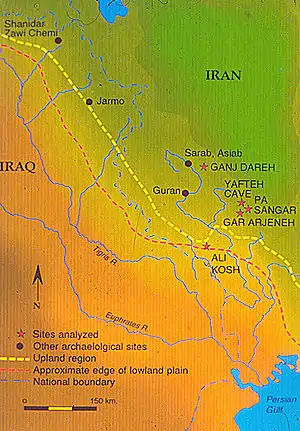Ганджи-Даре
Ганджи-Даре, перс. تپه گنج دره, букв. «долина сокровищ»,[1] — поселение эпохи неолита на территории Иранского Курдистана, к востоку от города Керманшах, в центральной части горного массива Загрос.[1]

Стоянка Ганджи-Даре была впервые открыта археологами в 1965 году. В 1960-70-е годы, вплоть до Иранской революции, её раскопки проводил канадский археолог Филип Смит.[1][2]
Остатки наиболее древнего поселения датируются около 10 000 лет назад[3], (VIII-VII тыс. до н. э) и являются наиболее ранними свидетельствами одомашнивания козы в мире[4][5][6].
Находки распределены по 5 уровням обитания, от A (верхнего) до E[7]. Известна керамика (строительный кирпич, чаши, сосуды, фигурки животных). Захоронения умерших производились внутри поселения.
У неолитических обитателей Ганджи-Даре были обнаружены Y-хромосомные гаплогруппы CT, P1 (xQ, R1b1a2, R1a1a1b1a1b, R1a1a1b1a3a, R1a1a1b2a2a) (по другим данным R2a-Y3399 и pre-R2-M479[8], по уточнённым данным, у четырёх образцов из Ганджи-Даре (8200-7800 BCE) определили Y-хромосомную гаплогруппу R2a-preY3399[9]) и митохондриальные гаплогруппы X2[10], J1c10.
У обитательницы Ганджи-Даре, жившей в 1430—1485 годах (430±30 л. н.), была определена митохондриальная гаплогруппа U1a1[11].
Примечания
- Smith, Philip E.L. Architectural Innovation and Experimentation at Ganj Dareh, Iran, World Archaeology, Vol. 21, No. 3 (February, 1990), pp. 323—335
- Smith, Philip E.L., Ganj Dareh Tepe, Paleorient, Vol. 2, Issue 2-1, pp.207-09 (1974)
- Zeder, Melinda A. & Hesse, Brian. The Initial Domestication of Goats (Capra hircus) in the Zagros Mountains 10,000 Years Ago Архивная копия от 17 июля 2011 на Wayback Machine, Science 287, 2254 (2000)
- What’s Bred in the Bone, Discover, July 2000 («After investigating bone collections from ancient sites across the Middle East, she found a dearth of adult male goat bones—and an abundance of female and young male remains—from a 10,000-year-old settlement called Ganj Dareh, in Iran’s Zagros Mountains. This provides the earliest evidence of domesticated livestock, Zeder says.»)
- Harris, David R. (ed.) The origins and spread of agriculture and pastoralism in Eurasia, pp. 208, 249-52 (UCL Press 1996) (Reprint ISBN 978-1857285383)
- Natural History Highlight: Old Goats In Transition Архивная копия от 20 декабря 2015 на Wayback Machine, National Museum of Natural History (July 2000)
- Yelon, A., et al. Thermal Analysis of Early Neolithic Pottery From Tepe Ganj Dareh, Iran Архивная копия от 22 октября 2016 на Wayback Machine, in Materials issues in art and archaeology III (1992)
- Y-SNP calls from the ancient Near East
- Narasimhan et al. (2019): A reanalysis of ancient Y-DNA haplogroups from Central Asia, South Asia, the Steppe, and Europe
- The genetics of an early Neolithic pastoralist from the Zagros, Iran. Scientific Reports 6, Article number: 31326 (2016).
- Iosif Lazaridis et al. The genetic structure of the world's first farmers, 2016.
Литература
- Wenke, Robert J. Patterns in Prehistory: Humankind’s first three million years. — 5th edition. — Oxford University Press, 2006. — 640 p. — ISBN 978-0195169287.
Ссылки
- Natural History Highlight: Old Goats In Transition Архивная копия от 20 декабря 2015 на Wayback Machine, National Museum of Natural History (July 2000)